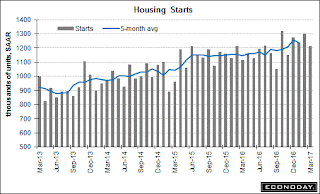The Mortgage Corner
The conforming 30-year fixed rate mortgage is now 3.50 percent and the so-called Hi-Balance conforming 30-year fixed rate is 3.75 percent for a 1 percent origination fee in California. And this is what has kept the demand for housing on a tear, in spite of tepid economic growth, with GDP growth still stuck at 2 percent per the Philly Fed Index seen below.
Why? It’s mainly because there is still very little inflation, and the bond market that determines mortgage rates likes low inflation. The low inflation rate may be because there’s still doubt on what growth-inducing legislation may ever get through a weak President and Congress stuck in ideological warfare. So we could see builders’ record profits continue for the rest of this year, and maybe more affordable housing.
Both new-home construction and builder optimism are at post-recession highs, but with normal seasonal fluctuations (such as mid-March Northeast blizzard), says the National Association of Home Builders (NAHB).
Following an elevated February reading, nationwide housing starts fell 6.8 percent in March to a seasonally adjusted annual rate of 1.22 million units, according to the U.S. HUD and the Commerce Department. Still, new housing production in the first quarter of this year is running 8.1 percent above the pace in 2016, reports the NAHB.
This is why builder confidence in the market for newly-built single-family homes remained solid in April, falling three points to a level of 68 on the National Association of Home Builders/Wells Fargo Housing Market Index (HMI) after an unusually high March reading, said the NAHB.
”The fact that current sales conditions has been over 70 for five consecutive months shows that there is continued demand for new construction,” said NAHB Chief Economist Robert Dietz. “However, builders are facing several challenges, such as hefty regulatory costs and ongoing increases in building material prices."The building industry is doing its share to boost growth as it continues to add jobs, with monthly employment data for February showing that home builder and remodeler employment increased by 18,900. Over the last 12 months, home builders and remodelers have added 136,000 jobs on a net basis and residential construction employment now stands at 2.707 million.
And where is US manufacturing activity these days? It’s still increasing in most states. The Philadelphia Federal Reserve has released the coincident indexes for the 50 states for February 2017. Over the past three months, the indexes increased in 47 states (green states), decreased in two, and remained stable in one (Michigan), for a three-month diffusion index of 90. In the past month, the indexes increased in 44 states, decreased in four, and remained stable in two, for a one-month diffusion index of 80.
“Here is a map of the three month change in the Philly Fed state coincident indicators. This map was all red during the worst of the recession, and almost all green now,” says Calculated Risk’s Bill McBride.So, economic growth continues into the eighth year of this business cycle. And housing is usually a leading indicator of future growth, but that will depend on what looks like lower interest rates, future (lower) inflation trends, actions of the Federal Reserve, and Congress, of course.
Harlan Green © 2017
Follow Harlan Green on Twitter: https://twitter.com/HarlanGreen



No comments:
Post a Comment